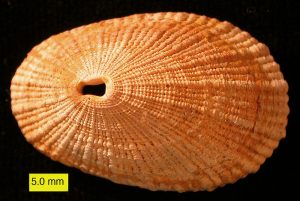We’ll start with a small fossil group recently placed among the lophophorates: the hyoliths. It is fitting to cover the hyoliths right after our other lophophorates, the brachiopods and bryozoans. Whether lophophorates are monophyletic or polyphyletic is currently debated. Here is the 2017 Nature paper placing the hyoliths among the lophophorates. Thanks, Ezra, for reminding me of the hyolithids as lophophorates.
Creatures with brains (more or less) are upon us! The polyplacophorans and monoplacophorans are usually covered early in a mollusk series because they have the least derived characters. Not much online about them for us. Gastropods, though, have their web fans. Read through this description of the poisonous gastropod Conus, its biology, and the medical aspects of its toxins. See how many people have been killed by this vicious snail. (“Vicious snail”, you say? Who would guess? Here’s an excellent National Geographic video of Conus catching and eating a fish.) You will be amazed by this website loaded with photos of gastropods in systematic order.
For fossil gastropods, Ron Fine of the Dry Dredgers has a colorful pdf description of Cincinnatian snails. You will find it useful for your field projects, including the introductory pages. The TXFossils site as many good images of fossil gastropods accessed by clicking on the county names.

A fissurellid gastropod from the Pliocene of Cyprus.
Geology in the News –
Here’s a nice summary of the latest ideas on the evolution of modern birds. It appears that the Cretaceous extinctions may have sped up their evolution, primarily by selecting for small body sizes which have higher rates of evolution.
Speaking of bird evolution, here’s that story of the “messy new species” of dinosaur-bird found in China. (This was on the back of your Quiz #5.) “The 127-million-year-old species, which they have named Jinguofortis perplexus, retains other features of its dinosaur ancestors, such as claws on the fingers of its wings, a jaw with tiny teeth rather than a beak, and a fused shoulder girdle. That last trait is seemingly poorly adapted to flight, hence the name perplexus.”
Here’s a strange new dinosaur from the Jurassic of South Africa: Ledumahadi mafube. It “crouched like a cat” and had strangely flexible forelimbs for a 12-ton animal. We are in a golden age of dinosaur paleontology. There are new discoveries every week.
